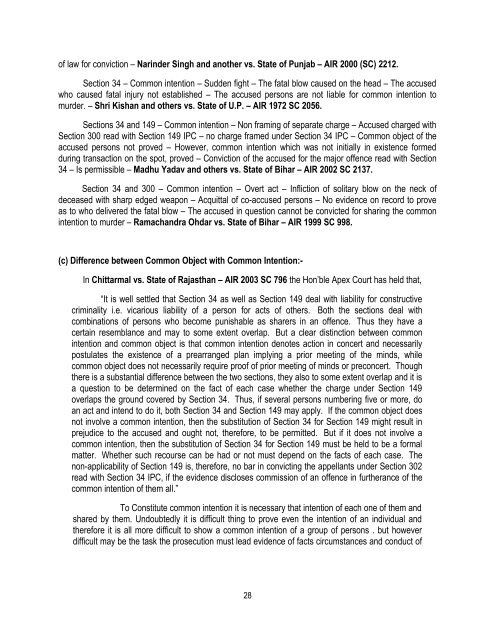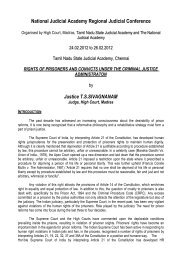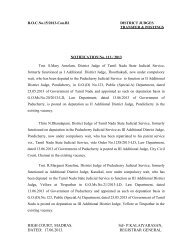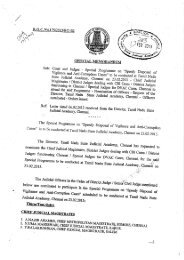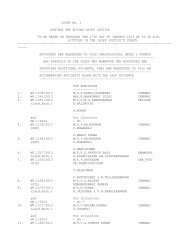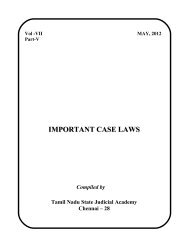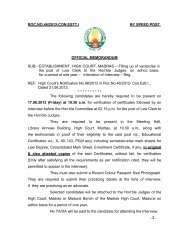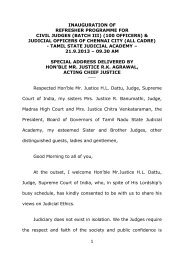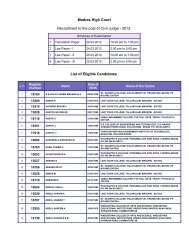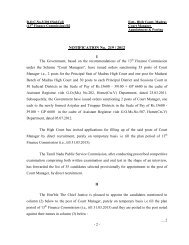Appreciation of Evidence in Sessions Cases - Justice D.Murugesan
Appreciation of Evidence in Sessions Cases - Justice D.Murugesan
Appreciation of Evidence in Sessions Cases - Justice D.Murugesan
You also want an ePaper? Increase the reach of your titles
YUMPU automatically turns print PDFs into web optimized ePapers that Google loves.
<strong>of</strong> law for conviction – Nar<strong>in</strong>der S<strong>in</strong>gh and another vs. State <strong>of</strong> Punjab – AIR 2000 (SC) 2212.<br />
Section 34 – Common <strong>in</strong>tention – Sudden fight – The fatal blow caused on the head – The accused<br />
who caused fatal <strong>in</strong>jury not established – The accused persons are not liable for common <strong>in</strong>tention to<br />
murder. – Shri Kishan and others vs. State <strong>of</strong> U.P. – AIR 1972 SC 2056.<br />
Sections 34 and 149 – Common <strong>in</strong>tention – Non fram<strong>in</strong>g <strong>of</strong> separate charge – Accused charged with<br />
Section 300 read with Section 149 IPC – no charge framed under Section 34 IPC – Common object <strong>of</strong> the<br />
accused persons not proved – However, common <strong>in</strong>tention which was not <strong>in</strong>itially <strong>in</strong> existence formed<br />
dur<strong>in</strong>g transaction on the spot, proved – Conviction <strong>of</strong> the accused for the major <strong>of</strong>fence read with Section<br />
34 – Is permissible – Madhu Yadav and others vs. State <strong>of</strong> Bihar – AIR 2002 SC 2137.<br />
Section 34 and 300 – Common <strong>in</strong>tention – Overt act – Infliction <strong>of</strong> solitary blow on the neck <strong>of</strong><br />
deceased with sharp edged weapon – Acquittal <strong>of</strong> co-accused persons – No evidence on record to prove<br />
as to who delivered the fatal blow – The accused <strong>in</strong> question cannot be convicted for shar<strong>in</strong>g the common<br />
<strong>in</strong>tention to murder – Ramachandra Ohdar vs. State <strong>of</strong> Bihar – AIR 1999 SC 998.<br />
(c) Difference between Common Object with Common Intention:-<br />
In Chittarmal vs. State <strong>of</strong> Rajasthan – AIR 2003 SC 796 the Hon’ble Apex Court has held that,<br />
“It is well settled that Section 34 as well as Section 149 deal with liability for constructive<br />
crim<strong>in</strong>ality i.e. vicarious liability <strong>of</strong> a person for acts <strong>of</strong> others. Both the sections deal with<br />
comb<strong>in</strong>ations <strong>of</strong> persons who become punishable as sharers <strong>in</strong> an <strong>of</strong>fence. Thus they have a<br />
certa<strong>in</strong> resemblance and may to some extent overlap. But a clear dist<strong>in</strong>ction between common<br />
<strong>in</strong>tention and common object is that common <strong>in</strong>tention denotes action <strong>in</strong> concert and necessarily<br />
postulates the existence <strong>of</strong> a prearranged plan imply<strong>in</strong>g a prior meet<strong>in</strong>g <strong>of</strong> the m<strong>in</strong>ds, while<br />
common object does not necessarily require pro<strong>of</strong> <strong>of</strong> prior meet<strong>in</strong>g <strong>of</strong> m<strong>in</strong>ds or preconcert. Though<br />
there is a substantial difference between the two sections, they also to some extent overlap and it is<br />
a question to be determ<strong>in</strong>ed on the fact <strong>of</strong> each case whether the charge under Section 149<br />
overlaps the ground covered by Section 34. Thus, if several persons number<strong>in</strong>g five or more, do<br />
an act and <strong>in</strong>tend to do it, both Section 34 and Section 149 may apply. If the common object does<br />
not <strong>in</strong>volve a common <strong>in</strong>tention, then the substitution <strong>of</strong> Section 34 for Section 149 might result <strong>in</strong><br />
prejudice to the accused and ought not, therefore, to be permitted. But if it does not <strong>in</strong>volve a<br />
common <strong>in</strong>tention, then the substitution <strong>of</strong> Section 34 for Section 149 must be held to be a formal<br />
matter. Whether such recourse can be had or not must depend on the facts <strong>of</strong> each case. The<br />
non-applicability <strong>of</strong> Section 149 is, therefore, no bar <strong>in</strong> convict<strong>in</strong>g the appellants under Section 302<br />
read with Section 34 IPC, if the evidence discloses commission <strong>of</strong> an <strong>of</strong>fence <strong>in</strong> furtherance <strong>of</strong> the<br />
common <strong>in</strong>tention <strong>of</strong> them all.”<br />
To Constitute common <strong>in</strong>tention it is necessary that <strong>in</strong>tention <strong>of</strong> each one <strong>of</strong> them and<br />
shared by them. Undoubtedly it is difficult th<strong>in</strong>g to prove even the <strong>in</strong>tention <strong>of</strong> an <strong>in</strong>dividual and<br />
therefore it is all more difficult to show a common <strong>in</strong>tention <strong>of</strong> a group <strong>of</strong> persons . but however<br />
difficult may be the task the prosecution must lead evidence <strong>of</strong> facts circumstances and conduct <strong>of</strong><br />
28


